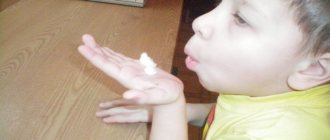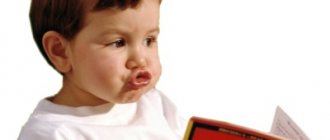One can understand the excitement of parents who suddenly discover that their preschool child speaks some sounds of their native language poorly or not at all. In this case, they are faced with the problem of how to teach the child correct sound pronunciation? Is this acceptable at home? Experts say that parents can do a lot to help a preschooler master correct sound pronunciation. You just need to have certain knowledge: about the causes of poor pronunciation, ways to correct it, ways to teach correct diction.
Causes of poor sound pronunciation
According to speech therapy standards, correct pronunciation should be formed by middle preschool age. However, even older preschoolers experience diction disorders. Experts provide evidence that children find it most difficult to pronounce hissing sounds: sh, zh, ch, shch. Imperfect diction can manifest itself in incorrect pronunciation of a sound, replacing one with another (machine-masyn), or skipping it. Experts identify the main reasons for poor pronunciation. These include the structure of the speech apparatus, insufficient development of phonemic hearing, perception, and the attitude of parents.
Features of physiology
- inactivity of the articulatory apparatus;
- improperly formed bite,
- short frenulum of the tongue,
- high palate.
Immaturity of phonemic perception
- The preschooler does not distinguish individual sounds by ear and replaces them.
Adult misbehavior
- Give the baby a pacifier for too long, especially during the period when speech is developing (early age);
- prolonged use of a pacifier leads to the formation of a malocclusion, which affects the pronunciation of many sounds, especially hissing sounds;
- deliberate distortion of speech by adults in order, in their opinion, to become understandable to the baby;
- dissatisfaction with the preschooler’s diction and the requirement to speak clearly, without teaching correct articulation;
- possible hearing loss not noticed by parents.
What are these sounds and how to pronounce them
Hissing sounds stand out from the rest by the acoustic noise they produce, that is, hissing. They can be pronounced correctly only with the lips open and slightly extended forward, while the teeth are almost closed. This creates a gap through which the air hisses. Thus, a striking example of a hissing consonant sound is the sound [ш], which is clearly pronounced in this way, without adding a voice. All four of these sounds are always pronounced while exhaling. At the same time, the sound does not pass from the sides: it is blocked by the tongue, pressed against the molars and hard palate. That is, in order to pronounce a hissing sound correctly, you need to “make” a ladle out of your tongue.
We can say that they are of a complex nature: they are difficult to pronounce not only for children, but also for many adults. To learn how to do this correctly, you need to monitor not only the position of your tongue and lips, but also the exhaled air: its stream passes approximately in the middle and should be wide enough. You can check this by raising your hand to your mouth.
If you monitor your articulation, you will notice that all hissing sounds are based on one thing - [w]. So, [g] appears if you add a voice to it, that is, trembling of the vocal cords. With [ш] the middle part of the tongue rises, and with [h] a stop in front of the labial-dental fissure is added to this rise.
How can you test a preschooler’s speech at home?
Having determined that a preschooler cannot speak hissing words, parents should contact a specialist. At home, they can also examine the child’s speech to understand which sibilants are distorted. According to speech therapy rules, the examination begins with a separate pronunciation of a certain sound, then it is pronounced in syllables, words, and only then in sentences. For example:
- The parent, asking the child to reproduce the hissing words sh, zh, ch, shch, pronounces them slowly and clearly. It is more interesting to offer a game form in the form of speech exercises: “The snake hissed: sh-sh-sh”, “The bee buzzed: w-w-w.”
- To check the state of sound in syllables, the baby is encouraged to repeat syllables, for example, shi-zhi, cha-sha, zhu-shu, chu-shu, ash-azh, ach-ashch, cabbage soup, chuh, shoo, whack. In this case, the sounds being tested must be at the beginning, middle, and end of the syllable.
- The next step is to check the pronunciation of sounds in words. For interest, pictures are used where objects are drawn for a given sound (cone, giraffe, hut, teapot, pike and others). In this case, you can use speech therapy visual material, or you can choose pictures in children’s books with your child. The main thing is that they comply with certain rules: hissing words must sound clearly in words, stand at the beginning of the word, the middle, the end (fur coat, car, reed). Using the same principle, words with other hissing words are selected: beetle, gun, skis, etc. It would be good if the examination took place in the form of game exercises. For example, “How to call it affectionately (bird-bird, goat-goat, beetle-bug, winter-winter, sun-sun)? »
- The last stage involves checking the sound in a sentence in which several words with the sibilant being tested are selected. Pure sayings serve this purpose well, for example, “Hush, mice, don’t make noise! Don’t wake up the cat!” Classic tongue twisters are suitable for examining hissing ones: “Sasha was walking...”, “Cuckoo cuckoo...”
Important! When examining a child, you need to try to determine the cause of incorrect pronunciation in order to understand what influenced the distortion of diction.
Whistling sounds: where to start staging
Usually, the production of sounds begins with the phoneme C. The first stage is preparatory. The child needs to be shown a picture with sound. You can draw this phoneme, mold it, make it from scrap materials. Explain how the tongue is positioned when pronouncing C (the tip rests on the lower teeth). It is advisable not to say that you are learning the sound C; it is better to name the phoneme, for example, “cold wind”. Next, articulation gymnastics is carried out.
Articulatory gymnastics for producing whistling sounds (exercises by L.A. Komarova)
- “Smile”
- stretch your lips in a smile and hold in this position. The teeth are not visible. - “Fence”
- smile so that your teeth are visible. Fix the position of your lips for a few seconds. - “Chick”
- open your mouth wide. The tongue lies calmly in the mouth. - “Punish a naughty tongue” - open your mouth slightly, put your wide tongue on your lower lip and say “five-five-five...”.
- “Spatula”
- place a relaxed tongue on the lower lip. Place the “spatula” in your mouth, trying not to strain your tongue. - “Tube”
- stick out your tongue and try to bend its edges up to form a “tube”. Blow into the “tube”. - “Jam”
- slowly lick your upper lip with your tongue, then the lower lip in a circle. - “Brushing your teeth”
- using the tip of your tongue, “clean” the lower teeth from the inside (from left to right, from top to bottom). We make sure that the lower jaw is motionless. - “Watch”
- open your mouth, the corners are stretched. The tip of the tongue moves to the right - to the left. - “Snake”
- using a narrow tongue to try to “bite” the palm placed in front of the mouth. The tongue moves forward and retracts back. It is important not to touch your lips and teeth. - “Candy”
– lips are closed. The tongue rests in turn on the left cheek from the inside, then on the right. - “Football”
- build a goal from cubes on the table, put a cotton ball in front of the child. The wide tongue rests on the lower lip. Blow on your tongue with the sound F, trying to move the cotton ball. Make sure your cheeks don't puff out.
Be sure to do exercises to develop air flow. The simplest ones: blowing soap bubbles, blowing out a candle, blowing on a paper boat, blowing cotton wool off a table.
Methods for producing sound C
A well-placed sound C allows you to quickly correct the pronunciation of Z and C, as well as sibilant phonemes. To get C, you need to rest the tip of your tongue on your lower teeth, stretch your lips in a smile and blow. If you bring the back of your hand close to your mouth, you feel a cold stream of air (“cold wind”).
The first way to produce sound is by imitation. In front of the mirror, invite the child to smile, show his teeth (“fence”) and blow on the “fence.” The tongue lies below. You can also imagine that you are pumping the wheels of a car. Pretend with your child that you are pumping tires and saying “sssssssssssssssssssssssssssssssssssssssssssssssssssssssssssssssssssssssssssssssssssssssssssssssssssssssssssssssssssssssssssssssssssssssssssssssssssssssssssssssssssssssssssssssssssssssssssssssssssssssssssssssssssssssssssssssssss scale basis].
If it is not possible to produce sound by imitation, then we try the mechanical method. A roll stick, a cotton swab, or a child’s finger will help here (of course, you need to wash your hands beforehand). We ask the baby to open his mouth. Pay attention to the tongue: sometimes the back is arched upward. Gently press the tongue with a stick or your baby's finger to create a groove through which air should pass. The baby covers his mouth, while keeping his lips in a smile, trying to blow. It turns out “ssss.” For some time, the child can press down the tongue with a finger until he learns to maintain the correct articulatory posture.
Automation C
After the individual sound C has been consolidated, the stage of phoneme automation in the child’s speech begins. For all sounds, automation follows the same scheme:
The most relevant and useful information for modern parents is in our newsletter. We already have over 30,000 subscribers!
- in straight syllables (sa, so, su);
- in intervocalic position (asa, oso, usu);
- in reverse syllables (as, os, us);
- with a combination of consonants (one hundred, one hundred, one hundred);
- in words (sound at the beginning of the word, in the middle and at the end: garden, wasp, pass);
- in sentences (Sonya is sledding);
- in poetry and pure sayings (Sa-sa-sa - here a wasp flies);
- in spontaneous speech (retelling a text, describing a picture).
With successful production of C, it is not difficult to obtain the sound Z: you need to “connect” the ligaments.
Invite your child to “ring” like a mosquito. Raise your index finger up, make rotational movements and make a “z-z-z” ringing sound. It is important to show the baby the difference between S and Z. Place the child’s palm against your throat and say “ssss” - the throat is calm. Now say “z-z-z” - your throat trembles. Let the child do the same on himself. For the sound T, two phonemes T and S are needed. To begin with, we ask the baby to say “t-s, t-s, t-s” and gradually increase the speed of pronunciation until Ts is achieved.
Each delivered sound is processed according to the scheme described above. Then we teach the child to pronounce soft phonemes (S', Z'). When the whistling sounds have become established in the baby’s speech, we begin to introduce the hissing sounds.
The order of setting hissing
If a child suffers from poor pronunciation of only a specific hissing sound (sh, ch, zh, sch), it is clear that work needs to be done on producing one sound. But, as a rule, preschoolers experience distortion in the pronunciation of several sibilants at the same time. Then it is important for parents to know which sound to start with first. Experts determine the appropriate order and warn that each sound must be played individually, starting with the most accessible, gradually moving on to more complex ones. According to speech therapists, the order of production of several sounds depends on the physiology of preschool children: first the hissing sh is placed, then zh, then ch and shch. However, there may be changes in the sequence of placement, since everything depends on individual characteristics, which only a specialist can determine.
How to properly work on developing sounds?
When setting up hissing sounds, the help of a speech therapist is undoubted. Only a specialist will professionally examine speech, identify violations and offer recommendations for correcting them in home exercises. This needs to be done as quickly as possible, since pronunciation problems interfere with children’s communication, slow down their preparation for literacy, and contribute to the emergence of related problems, for example, psychological complexes, which will have to be eliminated in the future.
Speech therapists note that often the problem when pronouncing hissing words is that the child cannot properly control the speech apparatus. That is why work on each sound must begin with articulatory gymnastics. It is performed using a mirror to see and understand the work of the jaw and oral cavity. In the future, this will have a positive effect on improving phonemic hearing, and therefore on sound pronunciation.
The first stage of working on hissing is preparatory, during which special exercises should be performed (for breathing, lips, tongue). They will help you practice precise movements of the articulatory apparatus and prepare to produce certain sounds. They are performed in the form of game exercises that are easy to do at home.
Working with tongue twisters
Tongue twisters are an excellent warm-up for children , which perfectly develops their speech skills. In the educational process they are used in different ways, in particular, in the study of sibilant consonants.
Invite students to read aloud several tongue twisters in a row. Moreover, the first time this must be done slowly, and then gradually increase the rate of pronunciation.
Ask the children what hissing sounds they found in tongue twisters, whether they differ from each other, and what their main characteristics are.
While taking dictation , offer to write down one of them in your notebook and ask students to underline the hard (or soft) sibilants. Invite one of the students to do this at the board.
Partial written work was mentioned above. It can also include homework. Sometimes workbooks contain tasks where you need to insert missing letters into words that contain certain sibilants. They should be emphasized.
So, we looked at what hissing consonant sounds are, how they can be identified, and with the help of what tasks you can teach a lesson at school on this topic.
Stage 1. Breathing training
Articulation gymnastics involves breathing training, practicing lip and tongue movements. For her, parents can use generally accepted speech therapy games, or they can come up with similar ones themselves. To interest a preschooler, you can involve him in preparing such games: cut out snowflakes, propellers for airplanes, boats, and colorful autumn leaves from light paper. The main thing is that the adult himself is passionate about the process, then the child will also perform the exercises with interest.
Exercises for breathing development
- “Kick the ball into the goal”, a game of unusual football. A gate is built in the center of the table and cotton “balls” are made. Players from both sides blow on cotton balls so that they fly into the goal. The adult monitors the child’s correct articulatory actions: a wide smile, tongue on the lower lip.
- "Snowflakes on the nose." Invite the preschooler to blow a cotton ball off his nose using the correct movements of the jaw: a wide smile, tongue on the upper lip, blow so that the ball flies up.
- The games “Blizzard”, “Leaves are Flying”, “Ships”, “Planes” are played in the same way.
Sibilants in a child's speech
Hissing ones include - [w], [zh], [h`], [sch`]. The formation of their correct pronunciation occurs between the third and fifth years of the baby’s life.
Incorrect pronunciation of “Sh”: types, reasons
Distortion or complete absence of sibilants in a child’s speech is called sigmatism. Depending on the type of incorrect placement, there are 4 types of sigmatism:
- Parasigmatism is a stable replacement of [sh] with another sound. Labial-dental - dental - replacement of [w] with [f]. Prizubny - replacing [w] with [t]. Hissing - replacing [w] with [sch]. Whistling - replacing [w] with [s] or [z]. Occurs with malocclusion or impaired phonemic hearing. Example: hat - slipper.
- Interdental sigmatism is the same “lisping” sound. Occurs due to a shortened frenulum or narrow soft palate.
Lesson with a specialist
- Lateral sigmatism - the sound [w] does not sound firm, as it should, but squelching, as if the baby had taken water into his mouth. Observed due to lateral open bite or weak tongue muscles.
- Nasal sigmatism - in a preschooler, the back of the tongue becomes very tense, and [w] can be pronounced with a nasal “echo.”
Before figuring out how to teach a child to pronounce the letter w, you should understand the reasons for the violation. Often a routine visit to the orthodontist, during which the bite or upper palate is corrected, ends with the long-awaited “hissing” of the baby. Otherwise, there is a need to develop the correct articulation pattern in speech therapy classes.
Articulation gymnastics for staging hissing
Before requiring the baby to pronounce a hissing sound, it is necessary to carry out preparatory articulatory gymnastics. Its duration is no more than 10 minutes. Despite the fast pace (so that the preschooler does not get bored), the child must perform each exercise carefully, since gymnastics directly determines how quickly a child can learn to say the sound [w].
Main tasks in articulatory gymnastics:
- Fence - a wide smile with teeth.
- Tube - the lips are gathered into a tube, there is a small gap between the lips.
- Alternating fence - tube.
- Hippopotamus - open your mouth wide and hold it for a while.
- Spatula - place a wide, outstretched tongue on the lower lip. You can “bite” with your tongue to make it wider.
- Homemade jam: lick the upper and then the lower lip with the tip of your tongue.
- Brush - move the tip of your tongue across the soft palate - from the throat to the teeth and back.
Articulation gymnastics
Tasks to determine the position of a sound in a word
At the beginning of the lesson, you can also develop phonemic awareness - determine the position of a sound in a word. To do this, you will need rich verbal and subject material.
- The child is asked to clap if he hears the “snake song (sound [sh]).” In this case, words are pronounced that contain the desired sound or do not contain them. You should not pronounce words with other hissing or mixed whistling sounds.
- The child is given a small sign with 3 windows indicating the beginning, middle and end of the word. And also a chip (cube/drawn sound). The teacher says the condition: “I will name the word, and you put the chip where the sound [w] is located.”
Learning to speak: vocabulary development in preschool age
Gymnastics for clear pronunciation
To correctly pronounce hissing sounds, speech therapy uses articulation and breathing exercises in combination. In this case, you should definitely remember about the correct position of the organs of articulation: lips and tongue.
Additional Information! Breathing exercises are aimed at developing smooth exhalation. To teach your child to perform breathing exercises, you need to create bright and interesting didactic material. For example, a flower with a butterfly sitting on it, which, according to the terms of the task, needs to be blown away.
Methodological basics for parents
It is important to know the correct position of the tongue and lips when pronouncing a sound in order to work on the exercises at home.
- Lips in the “tube” position;
- The tongue is wide, the tip is raised upward;
- The lateral parts of the tongue are in contact with the teeth of the upper jaw;
- A small gap forms between the palate and the tongue in the area of the upper incisors.
Stage 2. Gymnastics for the articulatory apparatus
Lip exercises
To warm up your lips, you can use speech therapy exercises:
- “We’ll be surprised and laugh.” The preschool child alternately makes a wide and narrow tube with his lips. A wide tube is in the “o” state, a “narrow” tube is in the “y” state. Nothing is said out loud, only the lips work.
- "Smile tube" Alternately, the child smiles widely, then makes a movement with his lips like the sound “o”.
Tongue exercises
Classic exercises are also used to train the tongue:
- “Delicious jam”, in which the tongue licks the lower lip, now to the left, now to the right.
- For the exercise “The Horse Is Galloping,” you need to “click” your tongue, imitating the horse’s step.
- “Elephant – Frog”: the lips alternately imitate either an elephant’s trunk or a frog’s smile.
- “Funny swing”: use the tip of your tongue to reach the upper teeth, then move down to the lower teeth.
- “Tick-tock”: with the tip of your tongue, imitating the movements of a watch, move left and right at different speeds.
- “Paints”: “color the palate” with the tongue.
All exercises are performed up to 10 times, but it is necessary to ensure that the baby does not get tired and exercises with interest.
A preschooler will quickly master the correct pronunciation of sibilants if the preparatory stage is carried out clearly, so they should not be neglected. The duration of such classes will depend on the individual development of the child and the state of his articulatory apparatus. Experts advise extending them if improvement does not occur after three sessions.










